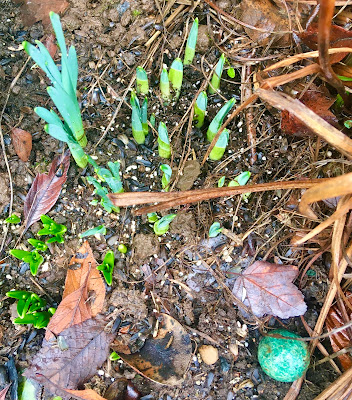Nature-culture is my way to live as part of nature; sharing my resources with those who share theirs (the bees and the birds, etc.); becoming more aware of nature's needs so I can be a better neighbor; changing my habits so I can cause less harm.
My working definition of Nature-culture is "Humans living in unity with nature: acting in ways that create shared spaces that mimic the diversity, stability, and resilience of natural ecosystems."
My working definition of Nature-culture is "Humans living in unity with nature: acting in ways that create shared spaces that mimic the diversity, stability, and resilience of natural ecosystems."
I've taken quite a bit off time off from my garden. It doesn't need much from me right now, and I'm not eager to go into the mud. But winter is a great time for observation, planning, and preparation, and today I will find a dry window to take a notebook and a camera outside for an observation session.
Agenda:
2. Prayer Candle ceremony
3. Read "Serviceberry"
4. Hope and Resilience
5. Bird and butterfly garden planning
6.
7. Brush and leaves
Review the Divine Laws:
At Soyal, I review the Divine Laws, as I see them. A Divine Law is anything that comes directly from God: a natural law, universal truth, principle, or a rule of conduct that is inherent and essential in human society.
Today I will review my testimony of Integrity: Be whole and undivided, and hold to my values and principles.
I'm enjoying a daily prayer candle ceremony throughout Soyal, using small candles and candle ends and choosing a new candle to add each day.
Today I light a purple candle for integrity, and ask the Spirits to bring the rain of loving care down upon the whole world.
3. Read "Serviceberry":
Today I'm reading from "The Serviceberry", by Robin Wall Kimmerer (2024). I got this sweet little book for Christmas.
Robin says, "If our first response to the receipt of gifts is gratitude, then our second is reciprocity: To give a gift in return. What could I give these plants in return for their generosity?" The gift could be a direct response like weeding or watering, or caring for the bees that pollinate the plant. Or it could be indirect, like donating to an environmental group, or making art, or advocating, educating, voting.
"We live in a time when every choice matters."
4. Hope and Resilience:
Hope and Resilience tasks: I defined a bit of real crisis, a vision of the change I want to see, and steps to take, along with one new resilience skill to build:
- Crisis: Biodiversity loss- Since 1955, biodiversity loss due to human activities has been greater than at any time in human history, caused by habitat loss, agriculture, over-exploitation, pollution, invasive species, and climate change.
- Vision: Increased urban habitat for birds and butterflies.
- Steps: Plan more native bird and butterfly habitat to plant.
- Resilience skill: Dress for the weather- get a new warm raincoat.
Well, I've got my new coat and I'm ready to brave the cold and get outside again!
5. Bird and butterfly garden planning:
Bird and butterfly habitat loss can be mitigated by strategically planning and designing urban butterfly gardens. The question then arises, how can these butterfly gardens be designed to best insure butterfly survival.
January is the perfect time to get my plans for the year in order. Next week, on Plow Monday, I'll begin vegetable garden plans, but today I'll start to think about new habitat for birds and butterflies.
- Choose what to plant: First I'll review what I planted last year, what did best, and new plants to try this year. (I'm thinking about a new small tree in the front yard ...)
- Map out the garden: Revise the plans.
- Make a planting schedule: Next, I need to determine the date to start each thing, and put it onto my planting spreadsheet, and my calendar.
- Start a native plant phenology journal
6. Start a phenology journal:
 |
| Oregon sunshine, 1-10-25 |
I've decided to study the phenology in my garden to broaden my awareness, deepen my connection to the wildlife around me, and to better understand the calendar of my environment and how it is changing. I'll focus on a few native plants and personal favorites in my yard, the birds at my feeder, and some specific patches of leaf mulch (for insects).
January 10, 2025, Phenology Notes:
 |
| Red-flowering currant, 1-10-25 |
- General: Sunrise = 7:48 am; Sunset = 4:47 pm; Day length = almost 9 hours. Temperature high = 54º; Low = 34º.
- Birds: I see lots of chickadees, some dark-eyed juncos, nuthatches, and a flock of small sparrows or finches that I haven't identified (brown with distinct black and white stripes on back, and forked tail). Also, my Anna's hummer.
- Plants: Oregon Sunshine - first flower buds opening; Daffodils - emerged; Red-flowering currant- bare; Snowberry- bare; Milkweed- dormant.
- Insects: Tiny white flea-flys in the leaf mulch (?)
- Fungi:
I've left quite a few leaves where they've fallen, but still have a large pile in the driveway to move. This week I plan to scoop and carry them to lay under the front shrubs.
I'm also building a couple of new “artfully designed brush piles” to 'frame pathways or create hedge-like borders": These are homes for desirable insects that enhance soil health and feed birds and other critters.





No comments:
Post a Comment